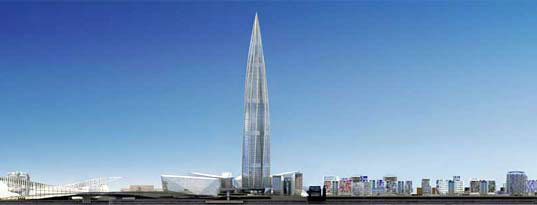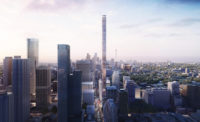At 1,322 feet, the St. Petersburg skyscraper would be Europe's tallest building. UNESCO is threatening to revoke the city's heritage status if the tower gets built.
November 23, 2010
 |
A skyscraper that would be Europe’s tallest is one step closer to reality, even if controversy continues to dog it.
The Okhta Centre in St. Petersburg, Russia, which is being designed by London-based RMJM, received a key approval last month from Glavgosekspertiza, the federal building agency, according to news reports. That approval was required because the steel-and-glass tower, which is to stretch to 1,322 feet, will be three times taller than the highest existing structure in the historic area.
Also green-lighted by the approval is a 190-acre complex to surround the tower on a former industrial site along the River Neva. That complex will include a concert hall, a museum, and parks, though details of the project are sketchy and could not be confirmed by any of the parties involved because of “confidentiality issues,” according to an RMJM spokeswoman.
All that now stands in the way of the project, permit-wise, is approval from St. Petersburg’s city hall, which is expected to grant it.
There’s a different potential snag, however. The United Nations Education, Scientific and Cultural Organization (UNESCO), which works to preserve historic sites through its World Heritage program, has threatened to strip St. Petersburg of its heritage status if the tower is built.
The city, which known as “Venice of the North” for its canals lined with 18th-century neoclassical architecture, has a notably low-slung skyline. And UNESCO officials say the tower would be too much of an imposition on it, according to Building Design, the British publication, echoing other reports. UNESCO officials did not return a call or e-mail from RECORD requesting comment. Both Gazprom and architect Tony Kettle, the project’s design director for RMJM, would not comment for the story.
Protests against Okhta Centre, including one that reportedly drew 3,000 people in October, suggests many residents are also against the approximately $2.5 billion project, which is being co-developed by the Russian government and Gazprom, the global energy company.
With its tapered, five-sided silhouette, the skyscraper has the appearance of an awl in renderings. RMJM architects have said the tower’s environmental footprint will be modest.
Despite losing key senior staff in the past year, RMJM has been busy, recently completing the East River Science Park in Manhattan, which consists of a stack of glass boxes hugging the FDR Drive. Other recent projects include the glittering University Town Library in Shenzhen, China, which is complete, and the sinuous Capital Gate tower in Abu Dhabi, the United Arab Emirates, which is under construction.


Post a comment to this article
Report Abusive Comment